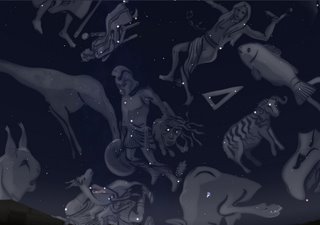Fall Skies, Welcome!

Session Name: 20060925.2145
Date/time: 25 Sept 2006, 9:45pm ~ 1:00am
Transparency/Seeing (1 worst - 5 best, for NYC skies): 4/4
NELM 5.2+, from Perseus, Triangulum, and Ursa Minor
Conditions: Windy at times where treetops bristled.
Session Name: 20060926.2040
Date/time: 25 Sept 2006, 8:40pm ~ 00:15am
Transparency/Seeing (1 worst - 5 best, for NYC skies): 4/4
NELM 5.2+, from Perseus, Triangulum, and Ursa Minor
Conditions: Mild weather, in a positive sense mostly clear, otherwise partly ______
--------------------------------------------------------------
Location: TotL, Central Park, NYC
Site Classification: Urban
Handheld Binos: Fuji 7x50
Tripod Mounted Binos: Takahashi 22x60
===============================
These past two evenings offered tremendously transparent skies. The second evening had bothersome clouds but the sky was still phenomenal. It felt at times that when we selected a clear patch the clouds would move in - naturally.
The first evening I observed solo and felt like I was able to cover a lot in the little time that I was there. Not many persons passed by. The world around me literally melted away while my attention was captured in easy celestial hunts and treasures unearthed.
 I wanted to test ride the Takahashi bins. I read a few reviews and was intent on performing some tests to get an idea of how well they perform. On my ride up to the park I began to write out a battery of tests, but in actuality I shared time between observing, sketching, and testing.
I wanted to test ride the Takahashi bins. I read a few reviews and was intent on performing some tests to get an idea of how well they perform. On my ride up to the park I began to write out a battery of tests, but in actuality I shared time between observing, sketching, and testing.{"Sketching" nothing like Jeremy at Belt of Venus }
Although sky conditions calculate into limiting magnitude, I selected NGC225 to conduct a test. I was able to see as dim magnitude 10.3. This cluster has an diamond-shaped arrangement of stars inside of greater perimeter of stars which I was unable to see. For the ambitious, if you go to the scanned map at WebDA , star number 9 was dimmest star I could resolve, number 10 the brightest of the interior diamond, which I didn't see, is magnitude 10.6.
Next item that I wanted to test was resolution, so I chose a number of doubles to get an idea of unequal brightness and separation values. On the second night I revisited these to get Charlie's impression. I believe we both agreed on resolving but had different impressions of
STF 205 A-BC (gamma And, Almach)
m: 2.31/ 5.02 1779: 9.3"/ 70° 2003: 9.5"/ 63°
could not resolve, suspected unequal secondary WNW to primary
STF 222 (59 And )
m: 6.05/ 6.71 1783: 15.3"/ 35° 2003: 16.5"/ 36°
appeared almost eq in brightness, secondary bluish
STF 60 AB (eta Cas)
m: 3.52/ 7.36 1779: 11.3"/ 62° 2003: 13.0"/319°
unequal double, secondary appeared reddish
STF 262 Aa-B (iota Cas)
m: 4.63/ 6.92 1782: 1.5"/290° 2002: 2.8"/231°
STF 262 Aa-C
m: 4.63/ 9.05 1779: 7.5"/101° 2003: 7.4"/116°
unable to resolve or even suspect
STF 485AE (double in the middle of NGC1502 (Perez || Ikebe sketch) at the end of Kemble's Cascade
m: 6.91/ 6.94 1830: 18.0"/303° 2002: 17.7"/305°
an equal pair of yellowish stars
STF 180 AB (gamma Ari, Mesarthim)
m: 4.52/ 4.58 1779: 10.2"/356° 2003: 7.4"/ 1°
cleanly resolved for me, not Charlie, eq brightness/white.
Another aspect of the binocular performance was to check where starpoints began to degrade such that they were not pinpoint sharp. I asked Charlie if he could make a judgment so I could see if we agreed. He determined that stellar image of magnitude ~7.5 began to degrade about 1/6 from edge to center. I was a little less tolerant and judged it to start around 1/5 from field stop to center of field of view. Degradation was not terrible at all, just that it began to loose sharp focus.
On both evenings I covered a pretty good range of objects and sky. Solar system objects included two very easy starhops to the planets Uranus in Aquarius and Neptune in Capricorn. Both are conveniently near bright stars which stay in the field of view. Thinking back, on the second night I relied on my sketches from the night before rather than checking the atlas to make sure I was in field. Saw a few meteors each night when Auriga had risen up to 25°+.
The summer sky is on its way down by midnight, I don't see Scorpio nor Antares in the southwest. I took this opportunity to check in M13,M56, M57, Albireo, and other objects that will soon be below the horizon when it gets dark. These days time seems to fly for me so might as well check 'em out while they're still up there.
Lastly regarding the size of field of view in the Tak bins, alpha-, epsilon-, and zeta Lyr just fit to the edge of the field of view. Epsilon^2, the other double of the Double Double doesn't fit. Objects that I think frame beautifully in these bins include the Muscleman Cluster in Perseus, nearby the Double Cluster which is also a beautiful sight. Orion's belt extending from NGC1981 down to iota is another favorite.
I've yet to get these to dark skies but when I do M31, M32, & M110 will be the Top of the List.
<< Home